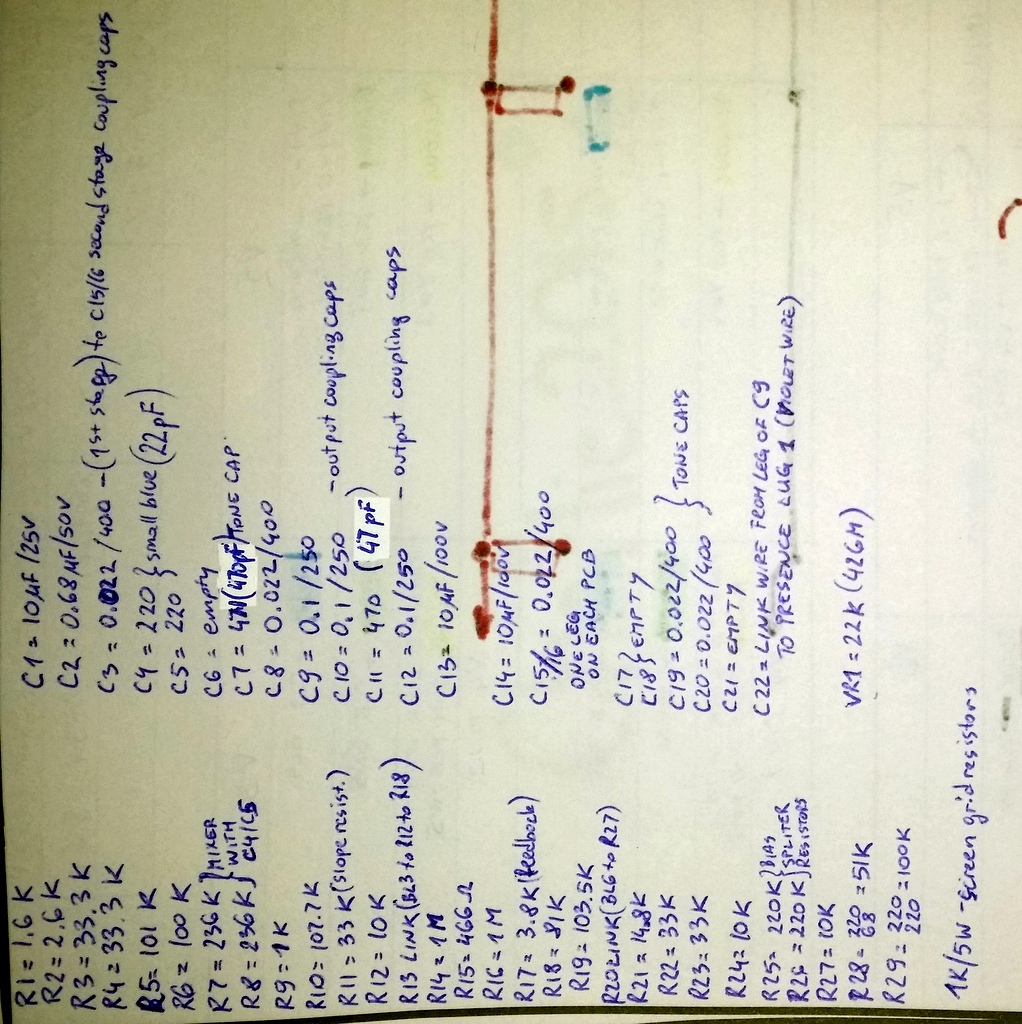Hi
I recently bought JTM45 2245 MKII (1995 model) online and when I got it the sound was very sterile, nothing like my 1959 RI that I used to own.
It came with Valve Art KT66 power tubes and Tung Sol 12AX7 in V1 and 2 stock
Marshall 12AX7 tubes in V2 and V3.
Rectifier tube was replaced with diodes soldered across the V6 pins.
Screen resistor 1K/5W soldered across pins 4&6 on V4 & V5
I checked the bias and left side was 30mA and right side 27mA.
Plate voltage was 446VDC and 450VDC (pin 3 on V4 and V5).
I tried to increase bias by turning VR1(22K) and highest current I got with VR1 maxed out
was 35/31.5 mA.
Someone before me has piggybacked/parallel wired two resistors in position R28 with
220K and 68K= 52K ; R29 with 2x220K=110K and also there are some components on the PCB
board that I can't find on any of schematics that I managed to download from the net.
I removed the piggybacked resistors from R29 and soldered the 180K resistor, value which I found in one of the schematics with KT66 in it.
Lowered the VR1 to its minimum and started it up.
Bias with VR1 at minimum on left side was 46.5mA(and increased to 50mA after 2 minutes)
and right side was 3mA less.
Plate voltage was 420VDC.
I shut it down coz I found it to be too high at lowest point of VR1.
What should I do to get the bias in the right bracket?
I have many photos of the PCB taken and voltages taken across all the pins plus all the resistor and capacitors numbers and values written down.
I would like if someone could have a look at them and tell me if there's any JTM45 RI schematic that is close to what I have inside or to point me to schematic which I should follow up to restore this amp to its best.
I'd like to experiment with return of rectifier tube and removal of the diodes from V6 which will drop the plate voltage down.
With that in place it would be another change with resistors around bias pot, I guess!?
For time being until everything is fixed let's work with diodes in place of rectifier just to get this thing going.
Your input would be much appreciated. Thanks
I recently bought JTM45 2245 MKII (1995 model) online and when I got it the sound was very sterile, nothing like my 1959 RI that I used to own.
It came with Valve Art KT66 power tubes and Tung Sol 12AX7 in V1 and 2 stock
Marshall 12AX7 tubes in V2 and V3.
Rectifier tube was replaced with diodes soldered across the V6 pins.
Screen resistor 1K/5W soldered across pins 4&6 on V4 & V5
I checked the bias and left side was 30mA and right side 27mA.
Plate voltage was 446VDC and 450VDC (pin 3 on V4 and V5).
I tried to increase bias by turning VR1(22K) and highest current I got with VR1 maxed out
was 35/31.5 mA.
Someone before me has piggybacked/parallel wired two resistors in position R28 with
220K and 68K= 52K ; R29 with 2x220K=110K and also there are some components on the PCB
board that I can't find on any of schematics that I managed to download from the net.
I removed the piggybacked resistors from R29 and soldered the 180K resistor, value which I found in one of the schematics with KT66 in it.
Lowered the VR1 to its minimum and started it up.
Bias with VR1 at minimum on left side was 46.5mA(and increased to 50mA after 2 minutes)
and right side was 3mA less.
Plate voltage was 420VDC.
I shut it down coz I found it to be too high at lowest point of VR1.
What should I do to get the bias in the right bracket?
I have many photos of the PCB taken and voltages taken across all the pins plus all the resistor and capacitors numbers and values written down.
I would like if someone could have a look at them and tell me if there's any JTM45 RI schematic that is close to what I have inside or to point me to schematic which I should follow up to restore this amp to its best.
I'd like to experiment with return of rectifier tube and removal of the diodes from V6 which will drop the plate voltage down.
With that in place it would be another change with resistors around bias pot, I guess!?
For time being until everything is fixed let's work with diodes in place of rectifier just to get this thing going.
Your input would be much appreciated. Thanks












 who guided me in right direction.
who guided me in right direction.